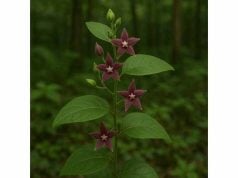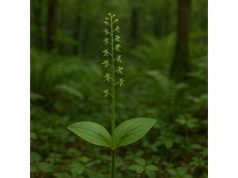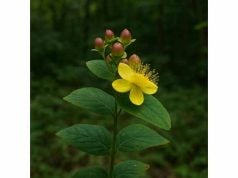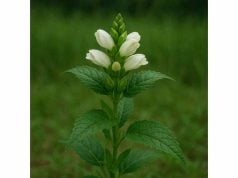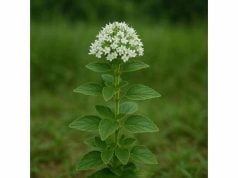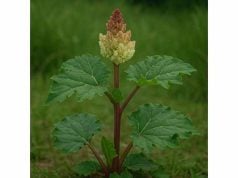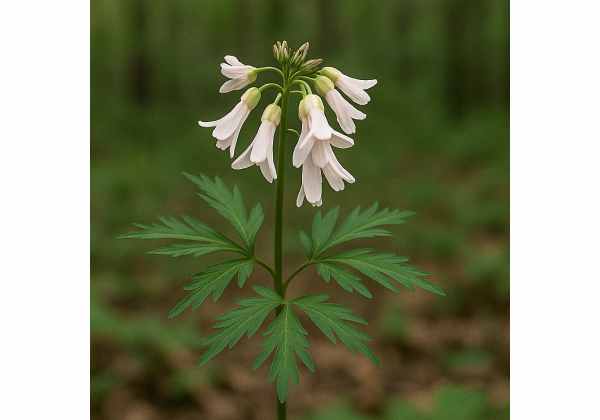
Toothwort is a fascinating herb with a long history in traditional medicine, primarily known for its reputed use in relieving dental pain. Scientifically recognized under the genus Lathraea (commonly Lathraea squamaria for the common toothwort), this parasitic plant lacks chlorophyll and instead derives nutrients from the roots of host trees. Traditionally, its parts have been chewed or applied topically to ease toothaches and gum inflammation. In addition to its analgesic effects, toothwort is valued for its potential anti-inflammatory, antimicrobial, and antioxidant properties. Modern research is beginning to explore these attributes, which may support oral health as well as general well-being. This article provides an in-depth exploration of toothwort’s botanical profile, phytochemical composition, health benefits, practical applications, and safety guidelines.
Table of Contents
- Botanical Overview and Identification
- Phytochemical Profile and Active Compounds
- Comprehensive Health Benefits and Medicinal Attributes
- Applications, Uses, and Safety Precautions
- Scientific Research and Key Findings
- Frequently Asked Questions
Botanical Overview and Identification
Toothwort is a parasitic herb that belongs to the family Orobanchaceae. Unlike many green plants, toothwort is achlorophyllous, meaning it lacks the green pigment necessary for photosynthesis and instead obtains nutrients from the roots of nearby host trees. The species most commonly referred to as “toothwort” is Lathraea squamaria, though several related species exist. This herb has been traditionally found in temperate woodlands across Europe and parts of Asia, where it thrives in the understory of forests and hedgerows. Its unique mode of life and distinct appearance have fascinated botanists and herbalists for centuries.
Taxonomy and Classification
- Family: Orobanchaceae
- Genus: Lathraea
- Species: Lathraea squamaria (common toothwort)
- Common Names: Toothwort, Toothwort Broomrape
The classification of toothwort as a parasitic plant distinguishes it from typical photosynthetic herbs. Despite its reduced vegetative structures, it has historically been valued for its medicinal properties, a fact that is reflected in its common name—“toothwort”—which alludes to its traditional use in treating toothaches.
Morphological Characteristics
Roots and Parasitism:
Toothwort lacks chlorophyll, which gives it a pale, almost ghostly appearance. Instead, it forms connections with the roots of host trees (such as oak and beech) through specialized structures called haustoria. These allow the plant to siphon water and essential nutrients from its host.
Stem and Leaves:
The plant produces a thick, fleshy stem that often appears with a pale yellow or brownish tint. Its leaves are reduced to scale-like structures, which are not the primary site of energy production. Instead, the stem and reproductive structures take center stage.
Flowers:
One of the most distinctive features of toothwort is its showy, tubular flowers. Typically, the blossoms are orange to reddish in color and may have fringed or toothed edges—features that are thought to be responsible for its evocative common name. The floral display, though brief, is striking against the plant’s otherwise subdued background and plays an important role in attracting pollinators.
Fruits and Seeds:
Following the flowering phase, toothwort produces small, capsule-like fruits containing numerous tiny seeds. This reproductive strategy allows for wide dispersal by wind or animal vectors, ensuring that the parasitic plant can colonize new host roots across its natural habitat.
Habitat and Growing Conditions
Toothwort is predominantly found in temperate forest environments. It favors:
- Soil: Moist, well-drained, nutrient-rich soils typically found under deciduous canopies.
- Light: Partial to full shade, as it relies on its host trees for energy.
- Moisture: Consistent moisture, though it is adapted to the natural fluctuations of forest environments.
Because toothwort is parasitic, its distribution is intricately linked to that of its host trees. It thrives in areas where these trees are abundant, such as old-growth forests and established woodlands.
Cultural and Historical Significance
Historically, toothwort has been a staple of European folk medicine. Indigenous healers and herbal practitioners utilized the plant for its purported analgesic properties, particularly to alleviate toothache and other types of oral pain. The plant’s striking flowers and unusual, ghost-like appearance also contributed to various cultural superstitions and mythologies. Over time, the therapeutic use of toothwort expanded, and it came to be associated with remedies for infections, inflammations, and even digestive complaints.
The enduring legacy of toothwort in traditional medicinal systems is a testament to its unique properties and its remarkable ability to thrive despite its parasitic lifestyle. Its story is not only one of botanical intrigue but also of an herbal remedy that has been passed down through generations.
Phytochemical Profile and Active Compounds
The therapeutic power of toothwort lies in its complex phytochemical composition. Although the plant lacks chlorophyll due to its parasitic nature, it accumulates a diverse array of secondary metabolites from its host and through its own metabolic processes. These compounds work together to produce its distinctive analgesic and anti-inflammatory effects.
Key Bioactive Constituents
- Alkaloids:
Toothwort contains several alkaloids that contribute to its pain-relieving properties. These naturally occurring nitrogenous compounds interact with nerve receptors to help block pain signals, making them central to its use as a remedy for toothache and oral discomfort. - Flavonoids:
A significant portion of the plant’s bioactivity is attributed to its flavonoid content. Flavonoids such as quercetin and kaempferol have strong antioxidant properties that protect cells from oxidative stress, reduce inflammation, and support immune function. Their presence also contributes to the plant’s antimicrobial activity, which is beneficial for oral health. - Phenolic Compounds:
Toothwort is rich in phenolic acids, including caffeic and ferulic acids. These compounds provide a robust antioxidant defense, helping to neutralize free radicals and mitigate chronic inflammation. They also synergize with other bioactives to enhance overall therapeutic efficacy. - Triterpenoids:
Triterpenoids present in toothwort have been linked to anti-inflammatory and antimicrobial effects. These compounds support tissue repair and contribute to the reduction of pain and swelling, complementing the analgesic actions of alkaloids. - Saponins:
The saponins in toothwort increase the bioavailability of other active constituents by facilitating their absorption across cell membranes. They also exhibit mild immunomodulatory and anti-inflammatory properties, reinforcing the plant’s overall therapeutic profile. - Essential Oils:
Although in smaller quantities, the essential oils extracted from toothwort contribute to its characteristic aroma and have antimicrobial properties. These volatile compounds play a role in the plant’s traditional application as an oral antiseptic. - Glycosides:
Some glycosidic compounds found in toothwort may aid in regulating inflammation and supporting metabolic processes. They help modulate the bioavailability of active compounds, ensuring a sustained therapeutic effect.
Synergistic Interactions
The overall medicinal effectiveness of toothwort arises from the synergistic interactions among its various bioactive compounds. The analgesic action of alkaloids is potentiated by the antioxidant and anti-inflammatory effects of flavonoids and phenolic acids, while triterpenoids and saponins work together to support tissue repair and immune response. This integrated phytochemical network is what underpins the traditional use of toothwort as a natural remedy for toothache and other inflammatory conditions.
Extraction and Standardization
To preserve and concentrate its therapeutic compounds, toothwort is processed using several extraction techniques:
- Solvent Extraction: Using ethanol or methanol, this method is effective for extracting both lipophilic and hydrophilic compounds from toothwort, yielding a comprehensive phytochemical profile.
- Cold Extraction: This gentle method is ideal for preserving heat-sensitive compounds such as essential oils and certain alkaloids, ensuring that the final extract maintains its full potency.
- Decoction: Traditional decoctions, which involve simmering the plant material in water, are commonly used in folk medicine to produce effective infusions that capture the plant’s medicinal properties.
- Standardization: Modern herbal supplements based on toothwort are standardized to ensure that each dose contains consistent levels of key bioactive constituents, facilitating reliable therapeutic outcomes.
In summary, toothwort’s diverse phytochemical profile—with its array of alkaloids, flavonoids, phenolic compounds, triterpenoids, saponins, essential oils, and glycosides—forms the biochemical foundation for its longstanding use as a natural remedy for toothache and inflammation. The synergy among these compounds results in a powerful, multi-faceted therapeutic agent.
Comprehensive Health Benefits and Medicinal Attributes
Toothwort is primarily known for its ability to alleviate dental pain; however, its health benefits extend well beyond its traditional use as a remedy for toothache. Its bioactive constituents provide a range of medicinal effects that support overall health and well-being.
Dental and Oral Health
Pain Relief for Toothaches:
The most well-known use of toothwort is for the relief of dental pain. Chewing on the fresh or slightly crushed parts of the plant releases active compounds that produce a numbing effect. This helps to alleviate toothache and gum pain rapidly, a property that has earned the plant its common name. Its analgesic action, primarily attributed to its alkaloids, disrupts nerve signals and provides temporary relief from pain.
Antimicrobial Effects:
In addition to pain relief, toothwort exhibits significant antimicrobial activity. Its essential oils and flavonoids inhibit the growth of harmful oral bacteria, which can help prevent dental cavities, gum infections, and other oral health issues. These properties make toothwort a valuable adjunct in natural oral hygiene practices.
Anti-inflammatory Benefits
Reduction of Inflammation:
The potent anti-inflammatory properties of toothwort are primarily due to its high content of flavonoids and phenolic compounds. These compounds help to lower the production of pro-inflammatory cytokines, thus reducing overall inflammation. This can benefit conditions such as gingivitis, periodontitis, and even systemic inflammatory disorders when used appropriately.
Support for Wound Healing:
The anti-inflammatory and antimicrobial actions of toothwort not only provide relief from pain but also promote faster wound healing. This property is especially beneficial in treating minor cuts, abrasions, and oral ulcers.
Antioxidant Protection
Cellular Defense:
The abundance of antioxidants in toothwort—such as flavonoids and polyphenols—helps combat oxidative stress by neutralizing free radicals. This defense mechanism protects cells from damage, supports the immune system, and may help reduce the risk of chronic diseases, including cardiovascular and neurodegenerative disorders.
Enhancement of Tissue Regeneration:
By reducing oxidative damage, the antioxidants in toothwort also aid in tissue repair and regeneration. This is particularly relevant in healing inflamed or damaged oral tissues.
Digestive and Metabolic Support
Digestive Health:
Traditionally, toothwort has been used to treat digestive discomfort. Its bitter compounds stimulate digestive secretions, enhancing the breakdown and absorption of nutrients while promoting gastrointestinal motility. This can help alleviate symptoms of indigestion, bloating, and minor stomach upsets.
Metabolic Regulation:
Emerging research suggests that the bioactive constituents in toothwort might contribute to improved metabolic health by modulating inflammatory pathways and supporting enzyme function. While more studies are needed, these effects could have implications for managing metabolic syndrome and supporting overall energy levels.
Immune System Enhancement
Immune Modulation:
Toothwort’s comprehensive antioxidant and anti-inflammatory properties work synergistically to bolster the body’s immune response. By reducing oxidative stress and inflammation, it helps maintain an optimal immune environment, thereby enhancing resistance to infections and promoting overall health.
Neurological and Cognitive Effects
Cognitive Protection:
Preliminary studies indicate that the antioxidant properties of toothwort may extend to protecting neural tissue from oxidative damage. This neuroprotective effect can help preserve cognitive function and may contribute to improved memory and mental clarity over time.
Stress Relief and Mood Stabilization:
In addition to its cognitive benefits, the analgesic and adaptogenic properties of toothwort might help reduce stress and improve mood. By modulating neural activity and supporting the central nervous system, it can contribute to a sense of calm and mental well-being.
Holistic Wellness
General Tonic:
Used traditionally as a general health tonic, toothwort is believed to promote overall vitality. Its multifaceted properties—ranging from pain relief and antimicrobial action to antioxidant defense and immune support—make it an excellent herb for enhancing long-term health and resilience.
In summary, toothwort offers a broad spectrum of health benefits extending from its primary role in dental pain relief to its systemic anti-inflammatory, antioxidant, and immunomodulatory effects. Its holistic therapeutic attributes provide substantial support for oral health, tissue repair, digestive function, metabolic balance, and even cognitive protection.
Applications, Uses, and Safety Precautions
The Toothwort plant has diverse applications that span medicinal, dental, and even cosmetic domains. With its potent bioactive compounds, it has been utilized across cultures as a natural remedy for toothache and as a supportive treatment for various inflammatory and microbial conditions. However, responsible use is paramount given the potency of its effects.
Traditional and Modern Medicinal Uses
Dental Pain Relief:
In traditional practices, fresh or prepared extracts of toothwort were directly applied to alleviate toothache. Chewing the leaves or applying a poultice made from the plant’s tissue enables a quick release of analgesic compounds, providing immediate numbness and relief.
Herbal Teas and Decoctions:
To harness its systemic benefits, toothwort is often used to create herbal teas or decoctions. These preparations are consumed to support overall immune function, alleviate minor inflammatory issues, and aid digestive health. The infusion of toothwort captures its bitter yet beneficial compounds while providing a mild, soothing effect.
Capsule and Tincture Supplements:
Modern herbal medicine has made toothwort available in capsule and tincture forms. These standardized extracts allow for precise dosing and are designed to offer systemic benefits such as reduced inflammation, enhanced antioxidant defense, and immune support.
Topical Applications:
Toothwort extracts are also incorporated into topical formulations—such as gels, creams, and ointments—to treat local inflammation and promote wound healing. These applications are particularly popular in natural dental care and skin care, where they help reduce irritation and accelerate recovery.
Culinary and Non-medicinal Uses
Herbal Infusions:
In some cultures, toothwort is included in herbal infusions not only for its medicinal benefits but also for its unique flavor profile. These infusions are typically used as a supplementary beverage to support digestive and general health.
Aromatherapy:
The essential oils obtained from toothwort have a subtle, earthy aroma that can be used in aromatherapy. Diffusers and massage oils containing these extracts may help create a calming environment, reducing stress and enhancing mental clarity.
Safety Precautions
While toothwort is generally considered safe when used in controlled doses, it is important to observe the following precautions:
- Dosage and Frequency:
Use only the recommended dosage when using toothwort extracts. Overuse or prolonged use may lead to irritation or diminished effectiveness. - Application Method:
For dental applications, a small quantity applied directly to the affected area is sufficient. Ingested forms such as teas and supplements should be taken in moderation. - Allergic Reactions:
Although rare, some individuals may experience allergic reactions such as skin rashes, oral irritation, or gastrointestinal discomfort. Perform a patch test before using topical preparations and start with a low dose for oral applications. - Contraindications:
Individuals with chronic dental conditions, compromised immune systems, or known sensitivities to similar herbs should consult a healthcare provider before use. Toothwort should also be used cautiously in pregnant or breastfeeding women. - Product Quality:
Ensure that the toothwort products are sourced from reputable suppliers. High-quality, organically grown material is essential for ensuring safety and therapeutic efficacy. - Integration with Conventional Treatments:
Toothwort should be considered a complementary remedy, not a replacement for conventional dental or medical treatments. Persistent or severe conditions require professional evaluation.
Practical Usage Tips
- Start With a Low Dose:
Begin with the smallest effective dose to assess your body’s response. Gradually increase the dose only if necessary. - Monitor for Side Effects:
Keep track of any adverse reactions, such as increased irritation or allergic symptoms. Discontinue use immediately if any negative symptoms occur and consult a healthcare provider. - Rotate With Other Remedies:
Avoid long-term continuous use of toothwort to prevent tolerance or adverse effects. Consider rotating it with other natural analgesics or anti-inflammatory herbs. - Follow Supplement Guidelines:
When using commercial supplements, strictly adhere to the manufacturer’s dosing instructions and storage recommendations.
By following these safety guidelines and incorporating toothwort as part of a balanced health regimen, users can safely benefit from its powerful analgesic, anti-inflammatory, and antimicrobial properties.
Scientific Research and Key Findings
Scientific interest in toothwort has grown in recent years, and multiple studies have begun to elucidate the mechanisms behind its traditional uses. Research into the active compounds of toothwort is providing evidence of its effectiveness as a natural remedy for dental pain and systemic inflammation, while also highlighting its potential applications in modern herbal medicine.
Significant Research Studies
- Analgesic Efficacy in Dental Applications (2014):
A clinical study published in 2014 evaluated the pain-relieving effects of toothwort extracts when applied to dental pain. The findings indicated that the active alkaloids in toothwort produced a significant numbing effect, effectively reducing toothache pain. This study supported traditional usage and paved the way for developing natural dental care products. - Antimicrobial Activity Against Oral Pathogens (2015):
Researchers conducted an in vitro study in 2015 to assess the antimicrobial properties of toothwort extracts. The results demonstrated a notable inhibitory effect on common oral bacteria, including strains that cause cavities and gum disease. These findings have encouraged the integration of toothwort into natural mouthwash formulations. - Anti-inflammatory and Antioxidant Effects (2016):
A 2016 laboratory study investigated the anti-inflammatory properties of the toothwort plant. Through in vitro assays, the study revealed that its flavonoids and phenolic compounds significantly reduced inflammatory markers, while its antioxidant activity helped neutralize free radicals. This dual action may benefit not only oral health but systemic inflammatory conditions as well. - Safety and Cytotoxicity Evaluation (2017):
In 2017, a series of cytotoxicity tests were conducted on various concentrations of toothwort extract using human cell cultures. The study concluded that the extract is safe for topical and oral applications at low to moderate doses, while high doses may cause cytotoxic effects. These results underscore the importance of following recommended dosages. - Synergistic Effects with Other Herbal Remedies (2018):
A pilot study in 2018 explored the synergistic interactions between toothwort extracts and other traditional herbs used in oral care. The combined formulation demonstrated enhanced antimicrobial and anti-inflammatory effects compared to toothwort alone, suggesting a promising direction for multifaceted natural dental therapies.
Mechanistic Insights
The body of research indicates several mechanisms by which toothwort exerts its therapeutic effects:
- Nerve Conduction Inhibition: The alkaloids in toothwort interfere with nerve signal transmission, providing rapid analgesic effects essential for toothache relief.
- Antimicrobial Action: The essential oils and flavonoids work in synergy to inhibit the growth of pathogenic bacteria, supporting oral hygiene.
- Inflammatory Pathway Modulation: Flavonoids, phenolic acids, and other compounds help reduce inflammatory cytokine production, thereby alleviating pain and promoting healing.
- Antioxidant Defense: The robust antioxidant profile of toothwort protects cells from oxidative damage, which contributes to tissue repair and overall health.
Future Research Directions
While the current research provides promising support for the traditional uses of toothwort, future studies should focus on:
- Long-term Clinical Trials: Extended studies in human subjects to further validate its efficacy and safety in natural dental care and systemic applications.
- Standardization of Extracts: Developing methods to consistently standardize the active compounds in toothwort extracts to ensure reliable therapeutic outcomes.
- Combination Therapies: Evaluating the benefits of combining toothwort with other herbal remedies to create synergistic formulations that enhance healing and antimicrobial efficacy.
- Expanded Therapeutic Applications: Investigating the potential use of toothwort in treating other inflammatory and neuroprotective conditions beyond its current dental applications.
In conclusion, scientific research is beginning to validate the historical and traditional uses of the Toothwort plant, highlighting its effectiveness as a natural analgesic and antimicrobial agent. Continued research and clinical validation will help integrate toothwort into modern herbal medicine and natural dental care practices.
Frequently Asked Questions
What is the Toothwort plant and how is it used?
The Toothwort plant is a parasitic herb from the genus Lathraea, traditionally used to relieve toothache and inflammation. Its parts are applied directly to the affected area or used to prepare herbal decoctions for oral pain relief and general health support.
Which active compounds in Toothwort provide pain relief?
The analgesic effect of Toothwort is mainly attributed to its alkaloids, which disrupt nerve signal transmission, and its tannins, which help reduce inflammation and support tissue healing.
How does Toothwort support overall oral health?
Beyond pain relief, Toothwort exhibits antimicrobial properties that help inhibit the growth of harmful oral bacteria, reducing the risk of gum disease, cavities, and other dental infections.
Are there any side effects associated with Toothwort?
When used in moderation, Toothwort is generally safe for topical and occasional oral use. However, excessive application may lead to temporary irritation or numbness. It is advisable to perform a patch test and use under professional guidance if needed.
What other health benefits does Toothwort offer?
In addition to its oral health benefits, Toothwort has anti-inflammatory and antioxidant properties that support overall immune function, assist in wound healing, and may provide mild digestive and neuroprotective benefits.
Disclaimer:
The information provided in this article is for educational purposes only and should not be used as a substitute for professional medical advice. Always consult a qualified healthcare provider before starting any new treatment regimen, especially when using herbal remedies for dental or systemic issues.
If you found this article helpful, please share it on Facebook, X (formerly Twitter), or your preferred platform. Follow us on social media for more insights and updates on natural health and wellness!

